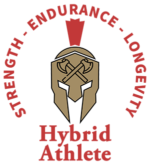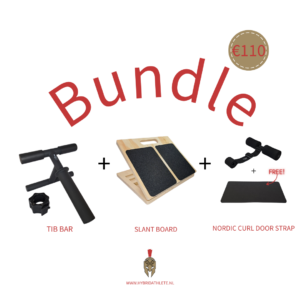
It’s the end of the year, and as true hybrid athletes, we would like to nominate tibialis training as a new year’s edition to your exercise routine.
We talk a lot about the importance of tibialis anterior development for all athletes, from lifters to runners and team sports players. It’s an often overlooked muscle that, if treated properly, can help with knee injury prevention.
So, this Christmas, treat yourself to a new regimen, and maybe a Tib Bar or a Solo Tib.
Now, let’s get into the details of tibialis training (with exercises), and let’s make sure everyone has a Merry Tibmas!
Table of Contents
A Quick Word About Tibialis Anterior
The tibialis anterior (or just tibialis) muscle is located on the shin (tibia = shin bone, anterior = in the front position). It plays a crucial role during the dorsiflexion movement. But, its purpose is not to help you land or squat with more power. A strong and developed tibialis anterior is the first line of defense against all the forces coming from running, jumping, landing, and quick direction changes.
So, in a way, tibialis anterior helps your knees absorb and evenly spread all the physical stress that comes from exercising.

Why choose tibialis training as your New Year’s resolution?
Even though the situation is getting better, athletes still don’t fully acknowledge the importance of tibialis training.
The truth is, modern exercising is getting more direct and more aggressive on the bodies of athletes, no matter what their discipline is. Just a few decades ago it was crazy to think that a human being could deadlift 500kg. Nowadays, there are more than a few people who achieved this feat and are aiming higher. The same applies to most sports – runners are getting faster, basketball players are jumping higher, and swimmers are getting wider. To make things even more interesting, this type of mindset used to be reserved for the top 1% of athletes. Today, we can see this approach at a local gym.
But this type of training comes at a cost. The first to take the hit is none other than – the knees. The thing is simple – if you want to prevent knee injury and keep exercising well into your old age, you have to start tibialis training. This muscle is the first line of defense you have against all sorts of knee and ankle injuries.
Tibialis Training Benefits
- Ankle stability and mobility
- Enhanced proprioception
- Knee and ankle injury prevention
- Foot stabilization (especially if you have flat foot issues)
- Better jumping and landing biomechanics
- Shin splint prevention
5 Best Tibialis Training Exercises (with progressions)
We created this tibialis training progression so you can pick it up regardless of your athletic level. Even some advanced athletes have underdeveloped tibialis anterior, so don’t be ashamed if you need to start extra slow. The good news is – the tibialis muscle recovers fast, so you will be able to bombard it with volume and frequency in no time. And, it never hurts to get humbled for a tiny bit.
1. Kneeling tibialis anterior stretch (aka seiza sit)
Also known as sitting on your heel, the seiza sit is a type of stretch anyone can build up. When you sit on your heels, the tibialis needs to work extra hard to stabilize your lower legs.
Here’s how to do a proper seiza sit:
- Find a nice padded surface and kneel with your legs slightly apart
- Now, plantar flex your ankles as much as you can. Don’t worry if you’re not able to go 180° right away.
- Slowly sit back on your heels while keeping balance (that’s when the tibialis is doing its work).
- Sit in this position with your back straight for about 30 seconds.
Seiza can be uncomfortable for people with weak plantar flexion. If you’re feeling pain or discomfort after 30 seconds, try going for 10 and build your way up.
2. Heel Walking
As the name suggests, this tibialis training exercise is the opposite of tiptoeing (sort of). Heel walking forces your tibialis to stay flexed to keep balance. This time under tension is especially impactful for people with frequent ankle and knee issues.
Here’s how to do heel walks:
- Place your feet shoulder-width apart and stand straight with your chest up
- While keeping your knees straight lift your toes and the balls of your feet up
- Without hinging at the hips, start walking forward. Keep your glutes active
- Take 10 steps and go back down
- Repeat for 3 sets
*it’s really important to keep your legs extended and your hips forward. Try your best not to compensate by bending your knees and sticking your behind out.
3. Bodyweight (aka wall) tibialis raises
This type of tib raise can be done practically anywhere. And, on top of that, you can go wild with volume and frequency, since there’s no extra load, and fatigue builds up reaaaally slowly.
Here’s how to do wall tib raises:
- Stand 1 foot (your foot) from the wall, facing away from it
- Lean against the wall with your behind. Make sure the hips are stable against the wall.
- Leading with your toes, with your heels dug into the floor, lift your feet up
4. Loaded tib raises
Now, once you’ve mastered the seiza sit, heel walks, and bodyweight tib raises, it’s time to load those tibs. And there’s no tibialis training without the famous Tib Bar (or Solo Tib, if you prefer unilateral training). Check out other variations in our tibialis raises guide.
Here’s how to do tib bar tibialis raises:
- Sit on a bench or a box with your legs sticking over the side
- Load the tib bar and place your feet into its slots. Make sure the tib bar is tight around your feet
- Let gravity pull your feet into plantar flexion as far as you can handle
- Push against it, leading with your toes, and pull the feet with the tib bar up
The Hybrid Athlete Tib Bar has many more uses. Click HERE to check them out.
Or, if you’re trying to decide whether to get the single-leg tib bar version check out this Tib Bar vs. Solo Tib guide.
5. Squat wedge loaded toe raise
Loaded toe raises, especially on an elevated surface, are an advanced form of heel walks (sort of). In this tibialis training exercise, you put extra tension on your shins, both through heel elevation and the extra load on your back.
This exercise is best done on a smith machine. And you will need a slant board or a pair of squat wedges to get things done efficiently.
Here’s how to do heel-elevated loaded toe raises:
- Set your slant board or squat wedges underneath the barbell (wedges should be parallel and shoulder-width at max).
- Get onto the wedges and unrack the bar (setup similar to heel-elevated high-bar squats)
- With your knees and back straight, raise the balls of your feet of the squat wedge
- Keep your toes up for a brief moment and slowly place them back on the squat wedge
- Repeat for a set of 8 to 12 reps
*A word of caution – start with an empty barbell because you can get hurt during this exercise if your feet aren’t stable on the squat wedge.
6. Deep split squat (ATG, KOT, lunges, and other quad-dominant squats)
Lastly, we leave you with the king of squats – the knees-over-toes split squat. Of course, split squats come in many variations, and you should always start with a bodyweight version. But that doesn’t change the fact that there’s rarely a better feeling at the gym than executing a fully controlled, loaded, unilateral KOT squat.
Here’s how to do a KOT split squat:
- Unrack the barbell
- Split your feet – put your working leg foot about 2 feet (your feet) in front of you
- Brace your core, squeeze the back glute and “sink” into your front leg while keeping it upright
- Focus on the front knee and push forward through it
- When at the bottom, push through your heel and go back. Keep your torso upright!

How often should you train your tibialis anterior?
Since we use the tibialis anterior in basically every movement that includes walking, running, or jumping, we can safely say that the muscle will recover quickly. That’s why you can, even as a beginner, start with tibialis training two times a week.
To introduce tibialis training gradually, simply put it into every leg day.
Keep your knees strong and bulletproof with tibialis training
There we have it, a tibialis training guide to help you run out of excuses for not training your tibs in the year 2025.
Jokes aside, if you’re even slightly into science-based training, and want to keep exercising well into your old age, start tibialis training asap.
We have all you need to get started, from guides to exercise gear. Everything you need to actually build a body that’s strong, fast, explosive, and above all, bulletproof.
Merry Tibmas !
Get the best injury-prevention training equipment here:
GET THE BEST INJURY-PREVENTION TRAINING EQUIPMENT:
Above all, a storyteller. Then comes marketing, branding, writing music, powerlifting, and woodworking.







